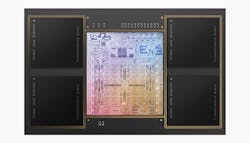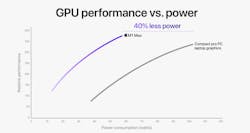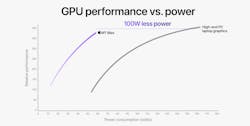Apple Raises Bar for Performance with M1 Max Chip for MacBook Pro
Apple is trying to hit Intel where it hurts with the M1 Pro chip in its latest MacBook Pro laptops. But the consumer electronics giant is pushing the envelope even further with its other new processor: the M1 Max.
The M1 Max is based on the same architecture as the standard M1 chip, which Apple placed in the latest MacBook Air and iPad Pro. Apple said it improved the interconnect fabric to pack more performance in the M1 Max along with more memory bandwidth and capacity. While it contains the same 10 CPU cores as the M1 Pro, the M1 Max offers far more graphics horsepower, with options for a 24-core or 32-core GPU that can take on high-end discrete GPUs from Nvidia and AMD.
Apple, which has been using Intel chips to power the Mac for the last 15 years, is in the middle of shifting its entire personal computer lineup to run on Apple-designed systems on a chip (SoCs) that resemble the ones used in the iPhone and iPad. While it already replaced Intel chips in its mid-range Mac with the M1 last year, it is now eyeing high-end laptops used by video editors, software developers, and others in the "pro" crowd.
The M1 Max packs 57 billion transistors based on the 5-nm process from TSMC, which is 70% more than the M1 Pro and 3.5 times more than the current M1, giving it what Apple said is "unparalleled" performance compared to most laptop chips. In terms of transistor count, the M1 Max is slightly ahead of Nvidia's 7-nm Ampere-based A100 server GPU, the most advanced graphics chip on the market with 54 billion transistors.
"It's the largest chip we've ever built by far," said Johny Srouji, senior VP of hardware technologies at Apple.
Previously, a MacBook Pro or other high-end laptop combined a high-performance CPU and power-hungry discrete GPU. That required the CPU and GPU to have separate pools of memory, forcing them to copy data back and forth to each other over the PCB. But the SoC approach used by Apple means the CPU and GPU in the M1 Max (and M1 Pro) can communicate with each other faster than a standalone CPU and discrete GPU.
As a result, the M1 Max can process data faster while using less power and venting less heat. The M1 Pro and M1 Max chips are a blow to AMD, which supplies the discrete GPUs in Apple's MacBook Pro laptops.
Apple said the 32-core GPU can match the performance of Nvidia's high-end GeForce RTX 3080 in a compact gaming laptop while burning up to 40% less power. Srouji said the M1 Max's GPU has roughly the same performance as another premium laptop with Nvidia's GeForce RTX 3080 while using up to 100 fewer watts. That means the system releases less heat, fans run more softly and less often, and the battery lasts longer per charge.
Apple said the GPU in its M1 Max pumps out up to 10.4 trillion floating-point operations a second (TFLOPS), double the performance of the M1 Pro and four times more than M1, which includes up to eight GPU cores.
While the M1 Pro supports 32 GB of unified memory, Apple said the M1 Max can be configured with up to 64 GB, a major improvement from 8 GB or 16 GB in the current M1. The M1 Max contains a high-bandwidth on-die fabric, doubling the memory bus from 256-bits in the M1 Pro to 512-bits, promising data rates up to 400 GB/s. That is around six times more memory bandwidth than the M1, which leverages LPDDR4X memory.
The M1 Max integrates many of the same building blocks as the M1 Pro chip, including the same 16-core neural engine for on-device machine learning acceleration, image signal processor (ISP), and secure enclave.
Keeping all the transistors from overheating was a top priority in the new MacBook Pro models. Apple said it overhauled the cooling system in the laptops with two fans for keeping the hardware cool, unlike the fanless M1-based MacBook Air. But John Ternus, VP of hardware engineering, said the power efficiency of Apple's silicon means they rarely have to turn on and, even when they do, they run more quietly than prior models.
Apple said it also upgraded the media engine in the M1 Max to offload video processing while increasing the laptop's battery life. According to Apple, the chip comes with the same hardware acceleration for codecs as the M1 Pro, but it has two video encode engines, two ProRes encode and decode engines, as well as a single video decode engine. That allows the M1 Max to run video encoding twice as fast as the M1 Pro, Apple said.
With the M1 Max, the new MacBook Pro can transcode video up to 10 times faster than the previous-generation 16-inch Macbook Pro, and it can support editing up to 30 4K ProRes videos or up to seven 8K videos in Final Cut Pro.
The new display engine in the M1 Pro and M1 Max can support several peripheral displays. With the M1 Pro, the new MacBook Pros can connect up to three Apple Pro Display XDRs, while the M1 Max can control three of the high-end displays and a 4K TV display. In addition, the 14-inch and 16-inch models have ProMotion screens with the same 120Hz refresh rate as the iPhone 13, an upgrade over the previous MacBook Pros.
The new MacBook Pro displays—like its latest iPad Pro—use miniLED technology for improved color reproduction. The screens also feature thinner borders on the side and a 60% thinner border at the top thanks to the iPhone-like notch.
The new laptops are priced at $1,999 for the 14-inch model and $2,499 for the 16-inch model.
Check out Part 1 to learn more about Apple's M1 Pro.
About the Author
James Morra
Senior Editor
James Morra is the senior editor for Electronic Design, covering the semiconductor industry and new technology trends, with a focus on power electronics and power management. He also reports on the business behind electrical engineering, including the electronics supply chain. He joined Electronic Design in 2015 and is based in Chicago, Illinois.



